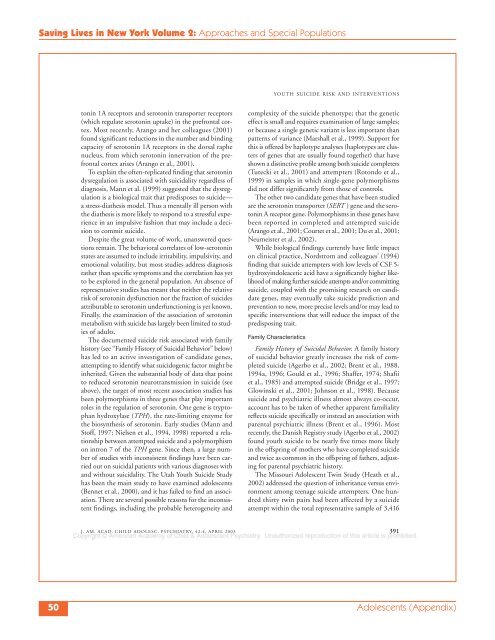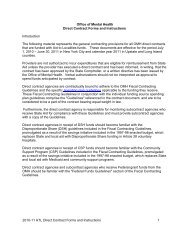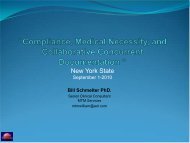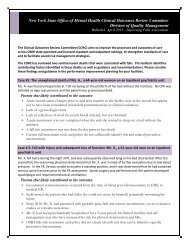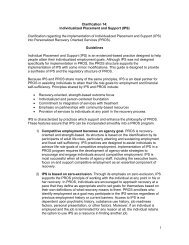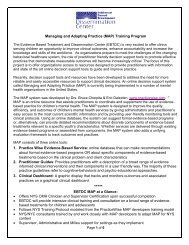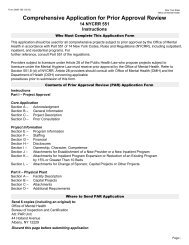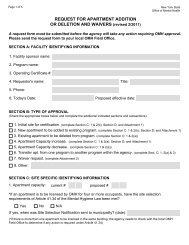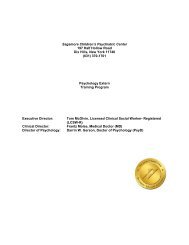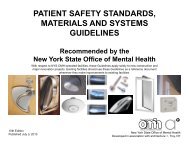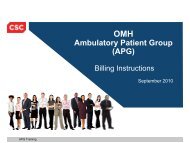Download - New York State Office of Mental Health
Download - New York State Office of Mental Health
Download - New York State Office of Mental Health
Create successful ePaper yourself
Turn your PDF publications into a flip-book with our unique Google optimized e-Paper software.
Saving Lives in <strong>New</strong> <strong>York</strong> Volume 2: Approaches and Special Populations<br />
YOUTH SUICIDE RISK AND INTERVENTIONS<br />
tonin 1A receptors and serotonin transporter receptors<br />
(which regulate serotonin uptake) in the prefrontal cortex.<br />
Most recently, Arango and her colleagues (2001)<br />
found significant reductions in the number and binding<br />
capacity <strong>of</strong> serotonin 1A receptors in the dorsal raphe<br />
nucleus, from which serotonin innervation <strong>of</strong> the prefrontal<br />
cortex arises (Arango et al., 2001).<br />
To explain the <strong>of</strong>ten-replicated finding that serotonin<br />
dysregulation is associated with suicidality regardless <strong>of</strong><br />
diagnosis, Mann et al. (1999) suggested that the dysregulation<br />
is a biological trait that predisposes to suicide—<br />
a stress-diathesis model. Thus a mentally ill person with<br />
the diathesis is more likely to respond to a stressful experience<br />
in an impulsive fashion that may include a decision<br />
to commit suicide.<br />
Despite the great volume <strong>of</strong> work, unanswered questions<br />
remain. The behavioral correlates <strong>of</strong> low-serotonin<br />
states are assumed to include irritability, impulsivity, and<br />
emotional volatility, but most studies address diagnosis<br />
rather than specific symptoms and the correlation has yet<br />
to be explored in the general population. An absence <strong>of</strong><br />
representative studies has meant that neither the relative<br />
risk <strong>of</strong> serotonin dysfunction nor the fraction <strong>of</strong> suicides<br />
attributable to serotonin underfunctioning is yet known.<br />
Finally, the examination <strong>of</strong> the association <strong>of</strong> serotonin<br />
metabolism with suicide has largely been limited to studies<br />
<strong>of</strong> adults.<br />
The documented suicide risk associated with family<br />
history (see “Family History <strong>of</strong> Suicidal Behavior” below)<br />
has led to an active investigation <strong>of</strong> candidate genes,<br />
attempting to identify what suicidogenic factor might be<br />
inherited. Given the substantial body <strong>of</strong> data that point<br />
to reduced serotonin neurotransmission in suicide (see<br />
above), the target <strong>of</strong> most recent association studies has<br />
been polymorphisms in three genes that play important<br />
roles in the regulation <strong>of</strong> serotonin. One gene is tryptophan<br />
hydroxylase (TPH), the rate-limiting enzyme for<br />
the biosynthesis <strong>of</strong> serotonin. Early studies (Mann and<br />
St<strong>of</strong>f, 1997; Nielsen et al., 1994, 1998) reported a relationship<br />
between attempted suicide and a polymorphism<br />
on intron 7 <strong>of</strong> the TPH gene. Since then, a large number<br />
<strong>of</strong> studies with inconsistent findings have been carried<br />
out on suicidal patients with various diagnoses with<br />
and without suicidality. The Utah Youth Suicide Study<br />
has been the main study to have examined adolescents<br />
(Bennet et al., 2000), and it has failed to find an association.<br />
There are several possible reasons for the inconsistent<br />
findings, including the probable heterogeneity and<br />
complexity <strong>of</strong> the suicide phenotype; that the genetic<br />
effect is small and requires examination <strong>of</strong> large samples;<br />
or because a single genetic variant is less important than<br />
patterns <strong>of</strong> variance (Marshall et al., 1999). Support for<br />
this is <strong>of</strong>fered by haplotype analyses (haplotypes are clusters<br />
<strong>of</strong> genes that are usually found together) that have<br />
shown a distinctive pr<strong>of</strong>ile among both suicide completers<br />
(Turecki et al., 2001) and attempters (Rotondo et al.,<br />
1999) in samples in which single-gene polymorphisms<br />
did not differ significantly from those <strong>of</strong> controls.<br />
The other two candidate genes that have been studied<br />
are the serotonin transporter (SERT ) gene and the serotonin<br />
A receptor gene. Polymorphisms in these genes have<br />
been reported in completed and attempted suicide<br />
(Arango et al., 2001; Courtet et al., 2001; Du et al., 2001;<br />
Neumeister et al., 2002).<br />
While biological findings currently have little impact<br />
on clinical practice, Nordstrom and colleagues’ (1994)<br />
finding that suicide attempters with low levels <strong>of</strong> CSF 5-<br />
hydroxyindoleacetic acid have a significantly higher likelihood<br />
<strong>of</strong> making further suicide attempts and/or committing<br />
suicide, coupled with the promising research on candidate<br />
genes, may eventually take suicide prediction and<br />
prevention to new, more precise levels and/or may lead to<br />
specific interventions that will reduce the impact <strong>of</strong> the<br />
predisposing trait.<br />
Family Characteristics<br />
Family History <strong>of</strong> Suicidal Behavior. A family history<br />
<strong>of</strong> suicidal behavior greatly increases the risk <strong>of</strong> completed<br />
suicide (Agerbo et al., 2002; Brent et al., 1988,<br />
1994a, 1996; Gould et al., 1996; Shaffer, 1974; Shafii<br />
et al., 1985) and attempted suicide (Bridge et al., 1997;<br />
Glowinski et al., 2001; Johnson et al., 1998). Because<br />
suicide and psychiatric illness almost always co-occur,<br />
account has to be taken <strong>of</strong> whether apparent familiality<br />
reflects suicide specifically or instead an association with<br />
parental psychiatric illness (Brent et al., 1996). Most<br />
recently, the Danish Registry study (Agerbo et al., 2002)<br />
found youth suicide to be nearly five times more likely<br />
in the <strong>of</strong>fspring <strong>of</strong> mothers who have completed suicide<br />
and twice as common in the <strong>of</strong>fspring <strong>of</strong> fathers, adjusting<br />
for parental psychiatric history.<br />
The Missouri Adolescent Twin Study (Heath et al.,<br />
2002) addressed the question <strong>of</strong> inheritance versus environment<br />
among teenage suicide attempters. One hundred<br />
thirty twin pairs had been affected by a suicide<br />
attempt within the total representative sample <strong>of</strong> 3,416<br />
J. AM. ACAD. CHILD ADOLESC. PSYCHIATRY, 42:4, APRIL 2003 391<br />
50 Adolescents (Appendix)


